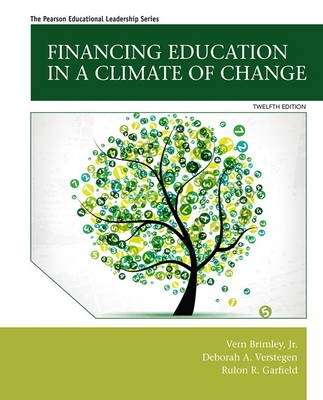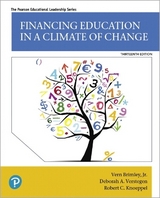
Financing Education in a Climate of Change
Pearson (Verlag)
978-0-13-391978-3 (ISBN)
- Titel erscheint in neuer Auflage
- Artikel merken
Dr. Vern Brimley has been a public school administrator for over 30 years, retiring as administrative assistant to the superintendent of Provo City Schools. He has been director of federal programs, purchasing, research, public relations an elementary teacher and principal. He served on the State of Utah committee delegated by the Utah State Legislature to study the Utah School Finance system giving several presentations to the committee. Twelve major changes resulted from this study, including equalization of capital outlay budgets. Dr. Brimley taught in a secondary modern school in Great Britain for a year on a Fulbright Exchange scholarship. He was selected as one of 40 educational administrators from throughout the U.S. and Canada to participate in the initial intensive two-month study program under the sponsorship of the National Academy for School Executives (NASE) – the training arm of the American Association of School Administrators (NASA) - and the Danforth Foundation. The Study-Leave Fellowship provided the opportunity for Dr. Brimley to study the financial structure of state educational systems and state departments of education. The Kettering Foundation designated him as an Innovative Educator. He has been a consultant for the Utah State Legislature Education Committee and was liaison with that body while with Provo schools. He has been a consultant for several school districts Dr. Brimley was a student of Professor Percy Burrup and did research for the first edition of Financing Education in a Climate of Change and was co-author of the third edition with Professor Burrup. He teamed with Dr. Rulon Garfield after Dr. Burrup’s death to write the fourth through eleventh edition and with Dr. Deborah Verstegen as co-author for the eleventh and twelfth edition. Dr. Brimley served as an Adjunct Professor at Brigham Young University and has taught many education leadership courses, but specialized in school finance and school business management. He has presented papers at conferences including the American Education Finance Association and has written articles on various education issues. He is married to Dawn Baker Brimley. They are the parents of three daughters and have ten grandchildren. Deborah Verstegen is a Professor of Educational Leadership, College of Education, University of Nevada, Reno. She served as Edwin J. O’Leary Chair of Financial Management, University of Illinois, Urbana-Champaign in 2006-07 and was a professor in finance, policy and leadership in the Curry School of Education at the University of Virginia for nearly two decades. Prior to joining the university community in 1984, she was a teacher, administrator and legislative aide in state government. She has had teaching experience at all levels, from pre-school, elementary, secondary, and community college, to university, at the graduate level. Her administrative experience in education is also broad. She has been a central office administrator for a K-12 school system in Alaska's Iditarod Area School District--which is approximately the size of Ohio and includes 14 schools and two preschools--Director of the Mid-management Program at the University of Texas at Austin, and Department Chair at UNR. She has worked in government as a legislative aide in Wisconsin's House of Representatives and as a lobbyist for the nonpartisan League of Women Voters of Virginia in the Virginia General Assembly. She was named Distinguished National Fellow in Finance in 2011 and developed an equity statistic, later named the “Verstegen Index” by scholars. Dr. Verstegen is actively involved in several professional associations and currently she serves as an Education Policy Editor for the JEF and serves on the Board of Advisors for the National Education Finance Conference. Currently, she is a tenured professor at the University of Nevada teaching graduate and undergraduate classes. Rulon Garfield, Ph.D., has a distinguished history in educational finance. As full Professor of Educational Leadership he sat in the finance-economic-policy chair at Brigham Young University formerly occupied by the late Percy E. Burrup. Just prior to accepting this position he was Director, Management Consultant Services, Coopers and Lybrand, assisting in finance and business administration issues for local districts, state departments of education, colleges and universities. He has been a Presidential Appointee of Gerald R. Ford as Chairman of the Federal Regional (VIII) Council; Regional Director (VIII) Department of Health, Education and Welfare; Lead Regional Director of Finance and Management, Lead Regional Director for Education, HEW; State Senator, serving on the Education and Appropriations Committees. His service included that of being a teacher in elementary school, junior high, high school, community college, college, university—undergraduate and graduate. As an educational leader at the elementary, secondary, district, state, and national levels he has had to solve many practical problems in educational finance. When chosen as an American Political Science Congressional Fellow, he served as a Legislative Staff Assistant in the United States House of Representatives and in the United States Senate as a Special Staff Assistant to the vice President of the United States. He is the author of numerous articles and three books, a speaker at national meetings and state conventions on educational finance. Dr. Garfield co-authored the fourth through the 10th editions of Financing Education in a Climate of Change with Dr. Vern Brimley and with the addition of Dr. Deborah Verstegen for the eleventh and twelfth edition.
Chapter 1 The Economics of Education
Education as Human Capital
Creation of Wealth and Education
Education: An Important Industry
A Public-Sector Responsibility
Economics and Social Progress
Economic Benefits of Education
Noneconomic Benefits of Education
Taxation and Education
Cost-Quality Relationship in Education
Chapter 2 The Need for Adequate Funds
Societal Impact on Educational Needs
Education Deserves High Priority
The Public Wants Good Schools
The Increasing Costs of Education
Demographic and Social Influences
The Consequences of Not Education People Adequately
Society Suffers the Effects of Poor Education
What is the Cost of an Adequate Education?
Chapter 3 Financing Education Equitably
Inequalities in Financing Education
Equity: An Objective of School Finance Reform
Equity at the School Level
Measures of School District Wealth
Historical Influences on Equity
The Equalization Principal
Improving State Equalization Practices
Foundation Program Variations
The Impact of Average Daily Attendance on Equity
The Changing Climate and Current School Finance Practices
Chapter 4 Patterns for School Finance Systems
Developing Patterns
Determining the Best Finance Plan
Full State Funding
District Power Equalization
Property Reassessment and Local District Revenues
Emphasis on Weighting Factors
Principal Types of Weightings
Chapter 5 Sources of Revenue
The Taxation System
Education- Financed by Government
Characteristics of a Good Tax System
Taxes for Education
Income Tax
Sales Tax
Property Tax
Excise Tax
Severance Tax
Other Funding Sources
Potential New Taxes
Chapter 6 Eroding Local Control
Changing Rural-Urban Influence on Education
Basic School District Administrative Units
The Administration of Local School Districts
Advantages of Local Control
Fiscal Independence of School Districts
Trends in Local Taxation Practices
Measure of Local Taxpaying Ability
Local, State, and Federal Tax Responsibility
Chapter 7 Education: A State Function
Early Development of State Responsibility
Development of Decentralized Educational Systems
Development of School Finance Policies
Developmental Stages of School Finance
The Varying State Programs
State Ability to Support Education
Chapter 8 Federal Interest in Education
Federalism
Historical Role of the Federal Government
U.S. Department of Education
Constitutional Role
Block Grants, Categorical Aid, and General Aid
Federal Expenditures
Fiscal Advantages and Disadvantages
Increased Government Service
The Future of Federal Aid to Education
Chapter 9 The Influence and Climate of the Courts
Three Waves of School Finance Litigation
The First Wave of School Finance Litigation
The Second Wave of School Finance Litigation
The Third Wave of School Finance Litigation: A Shift from Equity to Adequacy
Second-Generation Adequacy Cases
Impact of School Finance Litigation over Time
Pressure for Reform
Finance Reform or Tax Reduction?
Court Decision Guidelines
Chapter 10 Public Funds and Nonpublic Schools
The Law and Church-State Relations
Educational Choice
Controversy Not Solved
Chapter 11 Financing School Facilities
Early Capital-Outlay Programs
The Need
Current Capital-Outlay Rulings
State Support
Equity in Financing Educational Facilities
The Federal Government and Capital Outlays
Capital-Outlay Finance Plans
School Bonding Practices
Other Alternatives
Impact Fees
Chapter 12 Administering the District and School Budget
Evolution of Budgetary Practices
Development of a Systems Approach to Budgeting
District and School Budgetary Approaches
District-Level Budgetary Practices
Administering the District Budget
School/District Coordination
Budgeting at the School Level
Challenge of Leadership
Chapter 13 Accounting and Auditing
The School Accounting System
The Changing Accounting Environment
Comprehensive Annual Financial Report
Characteristics of Governmental (Fund) Accounting
Encumbrance Accounting
Cost Accounting
Accrual Accounting
Receiving and Depositing Funds
Expending School Funds
Auditing
Protecting School Funds
Chapter 14 Business Aspects of the School Community
Increased Safety Hazards
The Business Office
Supplies and Equipment
Purchasing
Supply Management
Risk Management
Transportation
School Food Services
Chapter 15 Human Resources and School Finance
The Expanded Role of Human Resources Administration
Teacher Compensation
Certification
Pay-for-Performance-- Merit Pay
Additional Issues
Teachers and School Finance
The Changing Assignments of Teachers
Administrative and Supervisory Salaries
Noncertified Personnel Salaries
Payroll Policies and Procedures
Government Influence
Chapter 16 The Road Ahead in School Finance
The Past as Prologue
The Continuing Climate of Change
Investments in Education
Improvements in Education
The Future of Public School Finance
Unresolved Issues
Some Characteristics of Educational Structure
School Finance Goals
The Challenge
| Erscheint lt. Verlag | 19.1.2015 |
|---|---|
| Sprache | englisch |
| Maße | 190 x 230 mm |
| Gewicht | 569 g |
| Themenwelt | Sozialwissenschaften ► Pädagogik ► Berufspädagogik |
| ISBN-10 | 0-13-391978-1 / 0133919781 |
| ISBN-13 | 978-0-13-391978-3 / 9780133919783 |
| Zustand | Neuware |
| Informationen gemäß Produktsicherheitsverordnung (GPSR) | |
| Haben Sie eine Frage zum Produkt? |
aus dem Bereich



